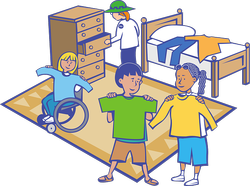Between four and five years old, the child must be taught to do the following for himself: use the toilet, bathe, dress up, button his clothes, buckle and tie his shoes, use a spoon and fork, eat and drink, comb his hair, brush his teeth, wash or wipe his face, clean his ears, and keep himself clean. These are best taught through actual demonstration and good example. It is important to monitor the child's progress in these aspects of gaining self-reliance.
Make a chart to mark your child's progress. The chart should be as simple as possible and hung in a conspicuous place. Divide it up by days of the week and list one or two specific goals. Every time he achieves one or both goals without your help, make a notation on the chart, using a symbol of his choosing, such as a star or a happy face.
Commend the child whenever an entry is made and encourage the rest of the family to do so too. If his behavior does not live up to expectations, leave the space empty and tell him that you hope he will do better the next day.
Seeing the chart fill up can be reward enough for your three-year-old, but an older child will need the reinforcement of a daily or weekly reward. The nature and quantity of the reward should be mutually agreed upon before hand.
Once he has successfully achieved his goals, take down the chart and, if you both agree, hang a new one with goals in another area of development. Be sure to reinforce each behavior by singling it out for praise.
At the same time, it is important to teach him to value cleanliness and good grooming. This is also a good time to teach him good manners.
|
Sun |
Mon |
Tue |
Wed |
Thu |
Fri |
| Bath |
|
|
|
|
|
|
| Dress up |
|
|
|
|
|
|
| Brush Teeth |
|
|
|
|
|
|
| Tie Shoe |
|
|
|
|
|
|
| Clean ears |
|
|
|
|
|
|
Eating and Drinking Properly
Teach the child to drink from a cup
- Put a few teaspoonfuls of milk into a cup and gently bring it to your child's lips. If he refuses to drink, try again another time. Never force him to drink.
- Then teach him to hold the cup on the sides while you support its botton. Encourage him with praise until he learns to hold the cup with both hands.
- To hasten the transition from bottle to cup feeding, do not let him walk around with bottle or take one to bed.
Teach him to feed himself
- Let the child sit at table with the family to expose him to the proper way of eating.
- Encourage the child when he tries to feed himself. Do not scold or fuss when he messes up the table. Make mealtime a happy occasion.
- Put just enough food in his bowl and drinking glass to avoid unnecessary spillage. The child can also consume small helpings more easily.
Teach the child to use spoon and fork
- First, help him hold the spoon then slowly allow him to hold it alone. Point out the way others hold their spoons. Show how pleased you are with his efforts.
- Then teach him how to hold a fork and pick up bits of food with it.
- Show him how to put food in his mouth with the use of the spoon or fork.
- Give the child his own spoon and fork. Make him understand that he must learn to feed himself like everyone else.










 Child Discipline Techniques That Workon 06/09/2012
Child Discipline Techniques That Workon 06/09/2012



Comments
Thanks for the visit!
This is good advice for new parents. Nice read!